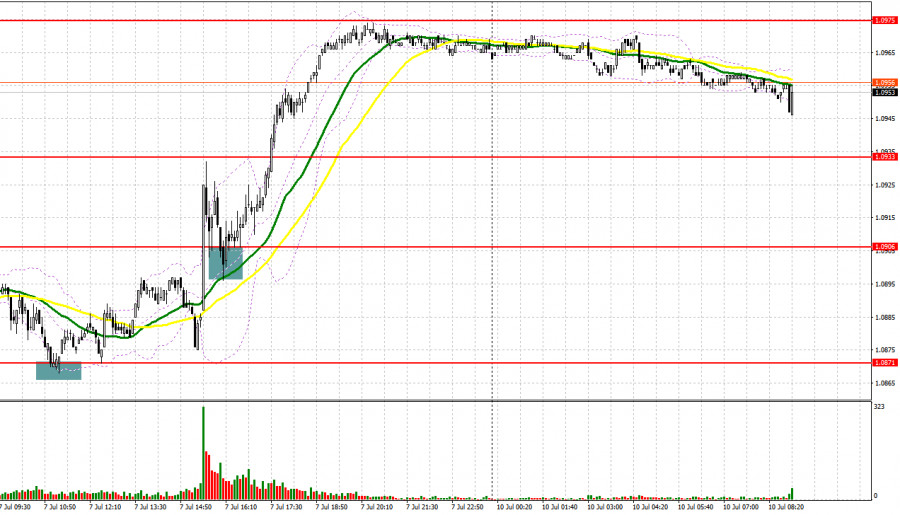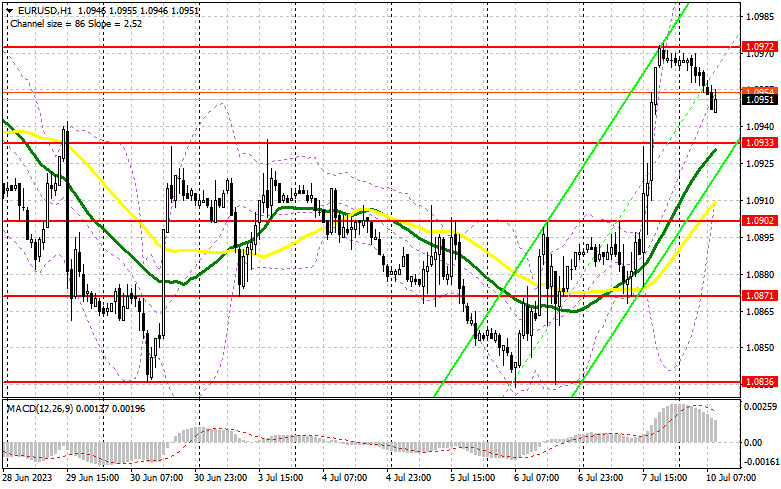

When to open long positions on EUR/USD:
The NonFarm Payrolls report released on Friday disappointed traders, which, as expected, led to a sharp rise in the euro against the US dollar. Now there is a possibility of a bullish movement in the market, but there is no need to rush with opening long positions. In terms of today's macroeconomic calendar, ECB Executive Board member Joachim Nagel, known for his hawkish rhetoric, will deliver a speech, and the Sentix investor confidence for the eurozone will be released. No other important releases are due. Therefore, the bears may continue the downward correction that began in the Asian session.
For this reason, I will only trade in the first half of the day after a decline and a false breakout through 1.0933 support. The bullish moving averages are located just below it. This will generate a buy signal capable of bringing the pair back to resistance at 1.0972, which has not been surpassed yet. A lot depends on this level. If the bulls take it under control, it will allow them to stop the downtrend and resume the uptrend. Only hawkish comments from ECB representatives and positive data from the eurozone will enable a breakout through this range. A breakout above 1.0972 and its test to the downside will boost demand for the euro. In such a case, quotes may return to a high of 1.1010. The most distant target remains the area of 1.1060, where I will take profits. In the case of a decline in EUR/USD and the absence of buyers at 1.0933, the pressure on EUR/USD will increase. Therefore, only a false breakout around 1.0902 support will make a buy signal. I will open long positions on a rebound from a low of 1.0871, aiming for a 30-35 pip bullish correction intraday.
When to open short positions on EUR/USD:
Sellers retreated on Friday amid weak US labor market statistics. The July meeting of the Federal Reserve is ahead, where interest rates will almost certainly be raised, maintaining the upside potential for the US dollar. Today, it is best to act after a rise and a false breakout near 1.0972 resistance, which will produce a sell signal with a potential decline in EUR/USD towards 1.0933 support, which recently acted as resistance. Consolidation below this range, as well as a retest to the upside, will lead the way to 1.0902. The most distant target is seen in the area of 1.0871, where I will take profits.

In the case of growth in EUR/USD during the European session and the absence of the bears at 1.0972, which is possible considering the Friday data on the US labor market, the bulls will attempt to establish a new upward trend. In this case, I will postpone selling until the next resistance at 1.1010. Selling is also possible there but only after failed consolidation. I will open short positions on a bounce from a high of 1.1060, aiming for a 30-35 pips bearish correction.
COT report:
The COT (Commitments of Traders) report for June 27 logged a drop in both long and short positions, leaving the market situation unchanged. The latest US GDP data confirmed the resilience of the American economy in the face of high interest rates, allowing the Federal Reserve to actively combat high inflation, gradually cooling it down. Currently, buying on declines remains the optimal medium-term strategy. According to the COT report, non-commercial long positions decreased by 5,422 to 223,977, while non-commercial short positions fell by 5,801 to 78,949. The total non-commercial net position increased slightly to 145,028 from 144,025. The weekly closing price increased to 1.1006 from 1.0968.
Indicator signals:
Moving averages:
Trading is carried out above the 30-day and 50-day moving averages, which indicates a bullish attempt to regain control over the market.
Note: The author considers the period and prices of moving averages on the H1 (1-hour) chart that differ from the general definition of the classic daily moving averages on the daily D1 chart.
Bollinger Bands
Support stands at 1.0902, in line with the lower band.
Indicator description:
Moving average (MA) determines the current trend by smoothing volatility and noise. Period 50. Colored yellow on the chart.
Moving average (MA) determines the current trend by smoothing volatility and noise. Period 30. Colored green on the chart.
Moving Average Convergence/Divergence (MACD). Fast EMA 12. Slow EMA 26. SMA 9.
Bollinger Bands. Period 20
Non-commercial traders are speculators such as individual traders, hedge funds, and large institutions who use the futures market for speculative purposes and meet certain requirements.
Long non-commercial positions are the total long position of non-commercial traders.
Non-commercial short positions are the total short position of non-commercial traders.
Total non-commercial net position is the difference between the short and long positions of non-commercial traders.